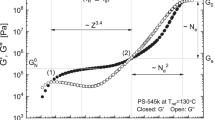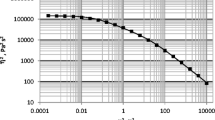Summary
Non-Newtonian flow and normal stress phenomena are studied with solutions of polystyrene in toluene with varying temperature, concentration and molecular weight.
The temperature dependence of normal and shear stresses of a solution with fixed concentration can be described in terms of the shift factor,a T , which is commonly used in the study of linear viscoelastic phenomena of polymeric systems.
From the measurements of normal and shear stresses the elasticity contribution to flow behavior of polymer solution can be evaluated, and its dependences on concentration and molecular weight are discussed. Each of the tested solutions shows more or less non-Newtonian viscosity behavior, especially very strongly in solutions with high concentration and high molecular weight. And these solutions are mainly “Hookean” in shear, but non-Hookean character appears in solutions with high concentration and with rather low molecular weight.
The zeroshear viscosityversus concentration relationship is found to obey ac 5-dependence in a certain range of concentration, while in the same concentration range the reciprocal of steady shear compliance shows ac 1,5 ∼c 2-dependence. The zeroshear viscosityversus molecular weight relationship of solutions at a fixed concentration obeys the well-knownM 3,4-dependence above a certain critical value of molecular weight which is dependent on the concentration. While the reciprocal of compliance is almost independent of molecular weight above this value, and it seems to be somewhat affected by the type of polymers such as molecular weight heterogeneity and/or degree of branching of the polymer.
Zusammenfassung
Nicht-Newtonsches Fließen und Normalspannungsphänomene wurden an Lösungen von Polystyrol in Toluol bei verschiedenen Temperaturen und Konzentrationen sowie bei verschiedenem Molekulargewicht untersucht.
Die Temperaturabhängigkeit der Normal- und Schubspannungen einer Lösung bestimmter Konzentration kann durch den „Schift-Faktor“a T , der allgemein bei der Betrachtung linearer viskoelastischer Phänomene polymerer Systeme gebraucht wird, beschrieben werden. Aus den Messungen der Normal- und Schubspannungen wurde der Elastizitätsbeitrag zu dem Fließverhalten der polymeren Lösung abgeleitet und seine Abhängigkeit von der Konzentration und dem Molekulargewicht diskutiert.
Jede der geprüften Lösungen zeigte mehr oder weniger nicht-Newtonsches Viskositätsverhalten, besonders stark ausgeprägt in Lösungen mit hoher Konzentration und hohem Molekulargewicht. Die Lösungen zeigten bei Scherbeanspruchung hauptsächlichHookeschen Charakter. Der nicht-Hookesche Charakter trat eher auf in Lösungen mit hoher Konzentration und bei niedrigerem Molekulargewicht.
Die Anfangsviskositäts-Konzentrationsbeziehunggehorcht einerc 5-Abhängigkeit in einem gewissen Konzentrationsbereich, während bei derselben Konzentration der reziproke Wert der Komplianz (Nachgiebigkeit) bei stationärem Scheren einec 1,5- bisc 2-Abhängigkeit aufweist. Oberhalb eines gewissen kritischen Wertes des Molekulargewichts, der von der Konzentration abhängt, gilt die bekannteM 3,4-Beziehung zwischen der Anfangsviskosität und dem Molekulargewicht.
Der reziproke Wert der Komplianz (Nachgiebigkeit) hängt fast nicht von dem Molekulargewicht oberhalb eines kritischen Wertes ab, aber das scheint durch den Typ der polymeren Substanz, wie Polymolekularität oder durch den Verzweigungsgrad, beeinflußt zu sein.
Similar content being viewed by others
References
Philippoff, W., Trans. Soc. Rheology1, 95 (1957).
Jobling, A. andJ. E. Roberts, Goniometry of Flow and Rupture in: Rheology edited byF. Eirich Vol. II, Chap. 13 (New York 1958).
Tamura, M., M. Kurata andT. Kotaka, Bull. Chem. Soc., Japan32, 471 (1959).
Kotaka, T., M. Kurata andM. Tamura, J. Appl. Phys.30, 1705 (1959).
Krieger, I. M. andS. H. Maron, J. Appl. Phys.23, 147 (1952);25, 72 (1954).
Greensmith, H. W. andR. S. Rivlin, Phil. Trans. Royal Soc. (London)345, 399 (1956).
Mooney, M., J. Colloid Sci.6, 96 (1951); J. Appl. Phys.24, 675 (1953).
Roberts, J. E., Ministry of Supply Reports No. ADE 13/52 (London 1952); Proc. 2nd Intern. Congr. Rheology, New York, 1953, p. 91 (London 1954).
Markovitz, H., Trans. Soc. Rheology1, 37 (1957).
Ferry, J. D., J. Amer. Chem. Soc.72, 3746 (1950); Structure and Mechanical Properties of Plastics, in: Die Physik der Hochpolymeren edited by H.A. Stuart, Bd.4, Chap. 6, p. 404 (Berlin-Göttingen-Heidelberg) 1956).
Johnson, M. F., W. W. Evans, I. Jordan andJ. D. Ferry, J. Colloid Sci.7, 498 (1952);T. W. De Witt, H. Markovitz, F. J. Padden, Jr. andL. J. Zapas, J. Colloid Sci.10, 174 (1955);D. J. Plazek andJ. D. Ferry, J. Phys. Chem.60, 289 (1956).
Fox, T. G. andS. Loshaek, J. Appl. Phys.26, 1060 (1955).
Author information
Authors and Affiliations
Rights and permissions
About this article
Cite this article
Kotaka, T., Kurata, M. & Tamura, M. Non-Newtonian flow and normal stress phenomena in solutions of polystyrene in toluene. Rheol Acta 2, 179–186 (1962). https://doi.org/10.1007/BF01972546
Received:
Issue Date:
DOI: https://doi.org/10.1007/BF01972546




